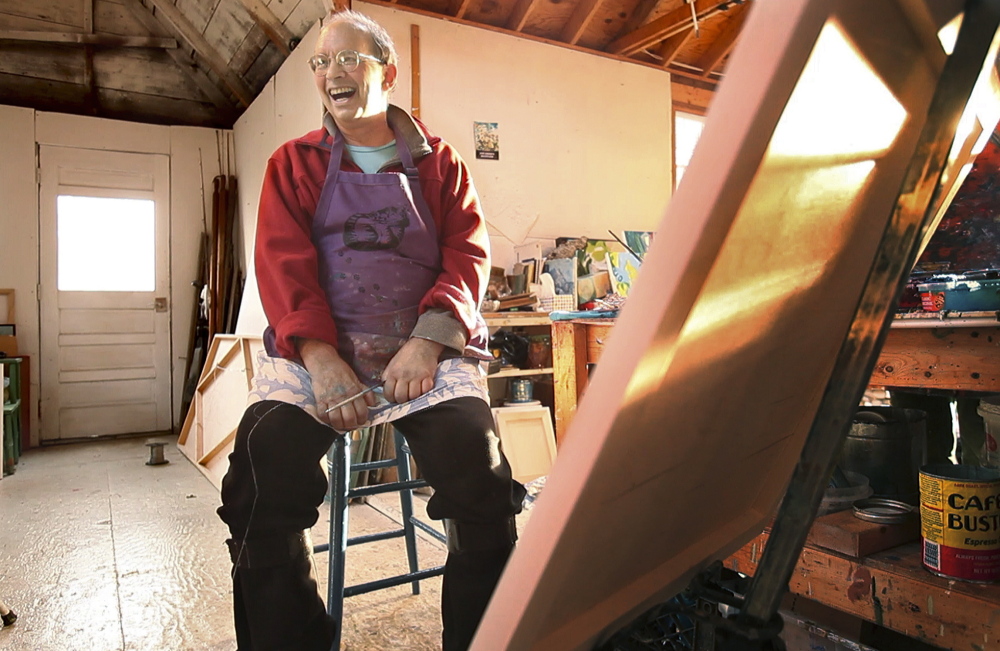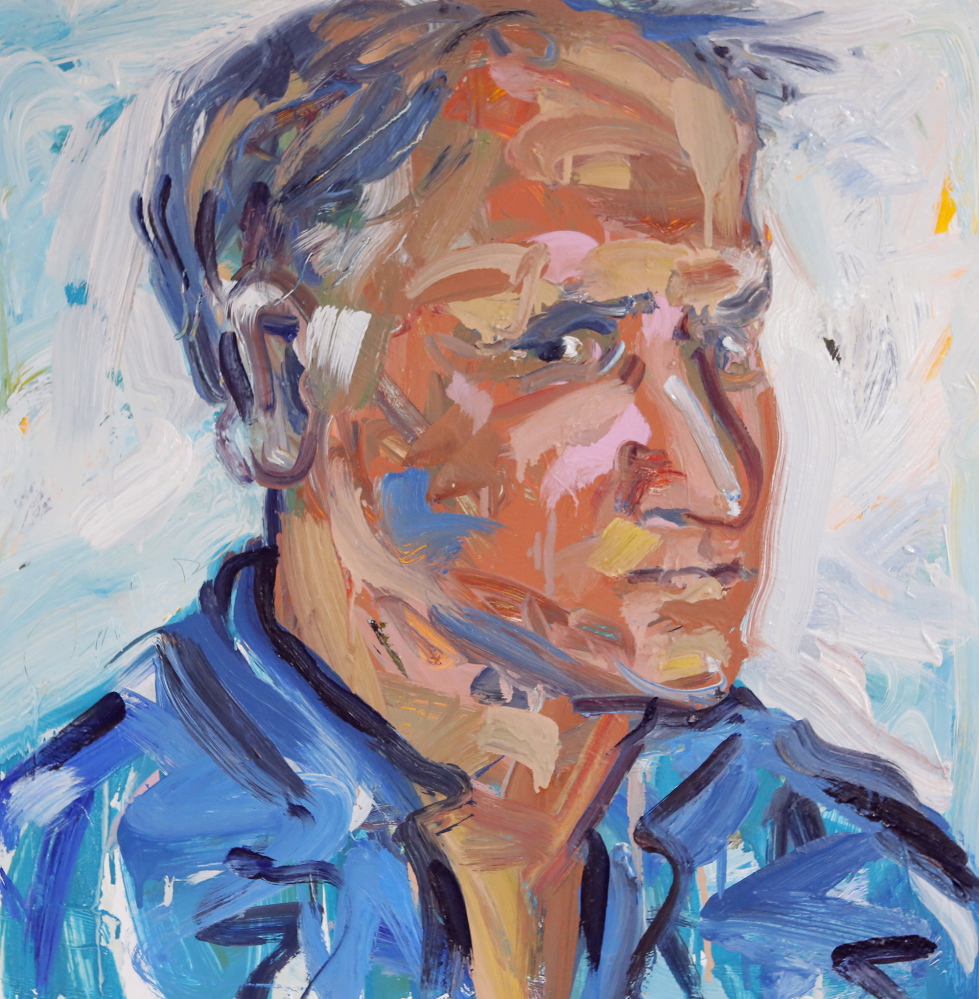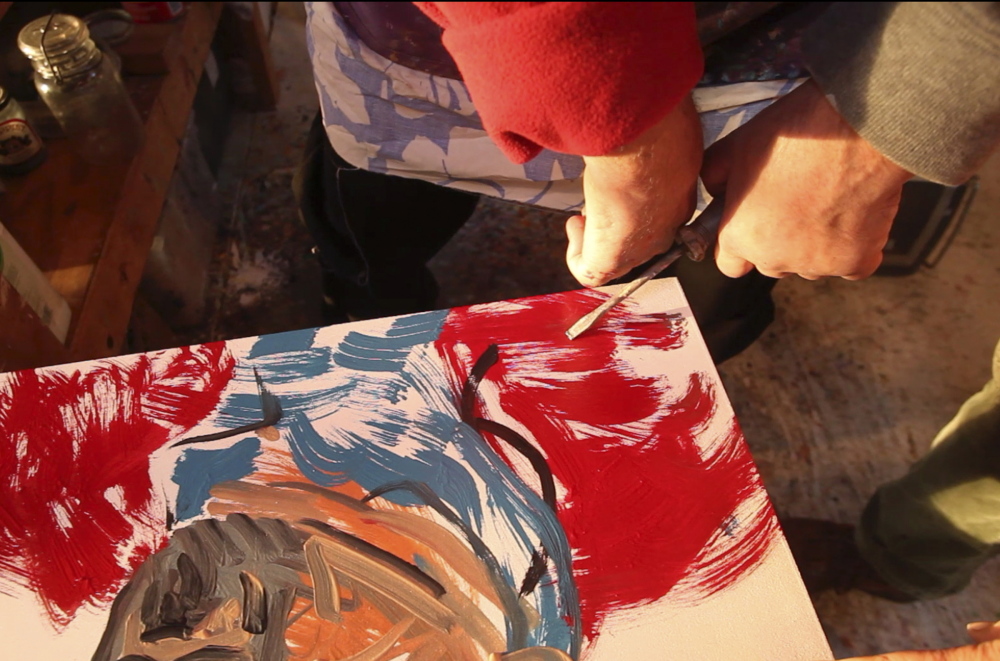“Jon Imber’s Left Hand” opens with the 63-year-old artist standing in front of a canvas with two helpers. He can hardly move and barely hold a brush. His speech has withered to grunts. The scene was shot on Feb. 10, 2014.
In the fall of 2012, Imber was diagnosed with amyotrophic lateral sclerosis, or ALS, the fatal degenerative condition also known as Lou Gehrig’s disease.
The next scene shows a robust and articulate Imber talking about art. He is friendly, forceful and witty. Fully aware of his prognosis but not yet seriously limited by the disease, Imber reveals his destiny: “I have just months.”
Months to live? Or months to paint?
This is the question underlying director Richard Kane’s bittersweet and deeply moving film, which premiered last week during the Maine Jewish Film Festival and is the latest in the superb Maine Masters series produced by the Union of Maine Visual Artists.
“Jon Imber’s Left Hand” picks up at the start of what Imber calls “my ALS summer.” It is a story about the artist and his wife, the painter Jill Hoy. The pair for decades have been key members of the Stonington and Maine painting communities. While Imber is the object of the film, Hoy is its true subject. We see Imber lean more and more on his loving wife. And while we watch him become a prisoner of his own failing body, it is Hoy’s heart that we feel breaking.
For Imber, the diagnosis is an urgent challenge: It motivates him to spend every last moment living.
And for Imber, art is life.
The film features a painting session in which ALS has forced Imber to switch to his left hand. Almost defiantly, Imber’s two-inch house brush glides with drippy-wet paint, boldly swishing and diving over a tall, slender canvas. Within minutes, the painting is beautiful – too beautiful.
So Imber flips over the canvas and goes back to work.
This reveals Imber’s goal, not to accurately paint the vase of flowers before him, but to make a good painting. For him, a satisfying outcome needs to resolve tension. Anything facile is too easy to be interesting, and this is why Imber’s ALS-forced switch leads to such surprisingly strong work.
While many painters are not used to people looking over their shoulder as they work, Imber, an extroverted teacher, is accustomed to an audience and to thinking out loud. This makes “Jon Imber’s Left Hand” an extraordinary document about both ALS and the artistic process.
Imber is a natural narrator, so Kane lets his voice set the pace of the film. Gallery reception conversations are buoyant and jaunty. Imber’s comments to crowds are funny and forceful but punctuated with time to look. And his intimate conversations are generous and patient.
Despite the insightful comments from an impressive cadre of colleagues, critics and curators, Kane lets the key questions and conclusions come from Hoy and Imber. Deep into his ALS, Imber is more dedicated to being a parent than painting (their son is a student at Bates College). But Hoy is persuasive when she finally lets the tears flow, saying “painting is his life.” She believes that, when he can no longer paint, Imber will depart. So Hoy does everything possible to keep him painting.
Imber knows his legacy will live on through his family and among the students he taught over 27 years at Harvard. And it will ride the ages in the scores of paintings we see throughout the film. Moreover, Imber has the measure of his post-diagnosis work: His newest abstract landscapes are as strong as anything he ever painted. And he knows it.
Kane shows Imber talking through his relationships with powerful figures such as his father and his teacher Philip Guston. (Despite Guston’s oversized role in Imber’s life, the key unspoken comparison of the film is with Willem deKooning both because of his approach to painting and the famous effect of Alzheimer’s on his career.)
Chatting over family photos, Imber claims his Judaism had little to do with his life and work, yet again the insightful Hoy persuasively disagrees. While this poignant scene binds the film brightly to the Maine Jewish Film Festival, it’s a family moment with which everyone can identify: It’s often easier, after all, for others to see our family in us.
The film closes with a return to the scene shot last month in Somerville with Imber heroically struggling against his failing body to paint – to live.
A masterpiece of intimacy in the face of tragedy, “Jon Imber’s Left Hand” is an extraordinary accomplishment in film. It is the eulogizing of the creative force and artistic life of one of America’s leading painters – in his own vibrant voice.
Freelance writer Daniel Kany is an art historian who lives in Cumberland. He can be contacted at:
dankany@gmail.com
Send questions/comments to the editors.





Success. Please wait for the page to reload. If the page does not reload within 5 seconds, please refresh the page.
Enter your email and password to access comments.
Hi, to comment on stories you must . This profile is in addition to your subscription and website login.
Already have a commenting profile? .
Invalid username/password.
Please check your email to confirm and complete your registration.
Only subscribers are eligible to post comments. Please subscribe or login first for digital access. Here’s why.
Use the form below to reset your password. When you've submitted your account email, we will send an email with a reset code.